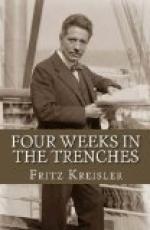Just then our own artillery came thundering up, occupied a little hill in the rear and opened fire on the enemy. The moral effect of the thundering of one’s own artillery is most extraordinary, and many of us thought that we had never heard any more welcome sound than the deep roaring and crashing that started in at our rear. It quickly helped to disperse the nervousness caused by the first entering into battle and to restore self control and confidence. Besides, by getting into action, our artillery was now focusing the attention and drawing the fire of the Russian guns, for most of the latter’s shells whined harmlessly above us, being aimed at the batteries in our rear. Considerably relieved by this diversion, we resumed our forward movement after about fifteen minutes of further rest, our goal being the little chain of hills which our advance guard had previously occupied pending our arrival. Here we were ordered to take up positions and dig trenches, any further advance being out of the question, as the Russian artillery overlooked and commanded the entire plain stretching in front of us.
We started at once to dig our trenches, half of my platoon stepping forward abreast, the men being placed an arm’s length apart. After laying their rifles down, barrels pointing to the enemy, a line was drawn behind the row of rifles and parallel to it. Then each man would dig up the ground, starting from his part of the line backwards, throwing forward the earth removed, until it formed a sort of breastwork. The second half of the platoon was meanwhile resting in the rear, rifle in hand and ready for action. After a half hour they took the place of the first division at work, and vice versa. Within an hour work on the trenches was so far advanced that they could be deepened while standing in them. Such an open trench affords sufficient shelter against rifle bullets striking from the front and can be made in a measure shell proof by being covered with boards, if at hand, and with sod.
In the western area of the theater of war, in France and Flanders, where whole armies were deadlocked, facing each other for weeks without shifting their position an inch, such trenches become an elaborate affair, with extensive underground working and wing connections of lines which almost constitute little fortresses and afford a certain measure of comfort. But where we were in Galicia at the beginning of the war, with conditions utterly unsteady and positions shifting daily and hourly, only the most superficial trenches were used. In fact, we thought ourselves fortunate if we could requisition enough straw to cover the bottom. That afternoon we had about half finished our work when our friend the aeroplane appeared on the horizon again. This time we immediately opened fire. It disappeared, but apparently had seen enough, for very soon our position was shelled. By this time, however, shrapnel had almost ceased to be a source of concern to us and we scarcely paid any attention to it. Human nerves quickly get accustomed to the most unusual conditions and circumstances and I noticed that quite a number of men actually fell asleep from sheer exhaustion in the trenches, in spite of the roaring of the cannon about us and the whizzing of shrapnel over our heads.




